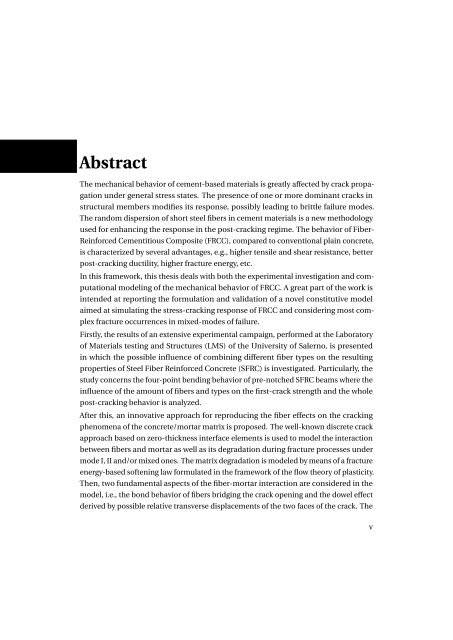tesi A. Caggiano.pdf - EleA@UniSA - Università degli Studi di Salerno
tesi A. Caggiano.pdf - EleA@UniSA - Università degli Studi di Salerno
tesi A. Caggiano.pdf - EleA@UniSA - Università degli Studi di Salerno
- No tags were found...
Create successful ePaper yourself
Turn your PDF publications into a flip-book with our unique Google optimized e-Paper software.
AbstractThe mechanical behavior of cement-based materials is greatly affected by crack propagationunder general stress states. The presence of one or more dominant cracks instructural members mo<strong>di</strong>fies its response, possibly lea<strong>di</strong>ng to brittle failure modes.The random <strong>di</strong>spersion of short steel fibers in cement materials is a new methodologyused for enhancing the response in the post-cracking regime. The behavior of Fiber-Reinforced Cementitious Composite (FRCC), compared to conventional plain concrete,is characterized by several advantages, e.g., higher tensile and shear resistance, betterpost-cracking ductility, higher fracture energy, etc.In this framework, this thesis deals with both the experimental investigation and computationalmodeling of the mechanical behavior of FRCC. A great part of the work isintended at reporting the formulation and validation of a novel constitutive modelaimed at simulating the stress-cracking response of FRCC and considering most complexfracture occurrences in mixed-modes of failure.Firstly, the results of an extensive experimental campaign, performed at the Laboratoryof Materials testing and Structures (LMS) of the University of <strong>Salerno</strong>, is presente<strong>di</strong>n which the possible influence of combining <strong>di</strong>fferent fiber types on the resultingproperties of Steel Fiber Reinforced Concrete (SFRC) is investigated. Particularly, thestudy concerns the four-point ben<strong>di</strong>ng behavior of pre-notched SFRC beams where theinfluence of the amount of fibers and types on the first-crack strength and the wholepost-cracking behavior is analyzed.After this, an innovative approach for reproducing the fiber effects on the crackingphenomena of the concrete/mortar matrix is proposed. The well-known <strong>di</strong>screte crackapproach based on zero-thickness interface elements is used to model the interactionbetween fibers and mortar as well as its degradation during fracture processes undermode I, II and/or mixed ones. The matrix degradation is modeled by means of a fractureenergy-based softening law formulated in the framework of the flow theory of plasticity.Then, two fundamental aspects of the fiber-mortar interaction are considered in themodel, i.e., the bond behavior of fibers bridging the crack opening and the dowel effectderived by possible relative transverse <strong>di</strong>splacements of the two faces of the crack. Thev
















